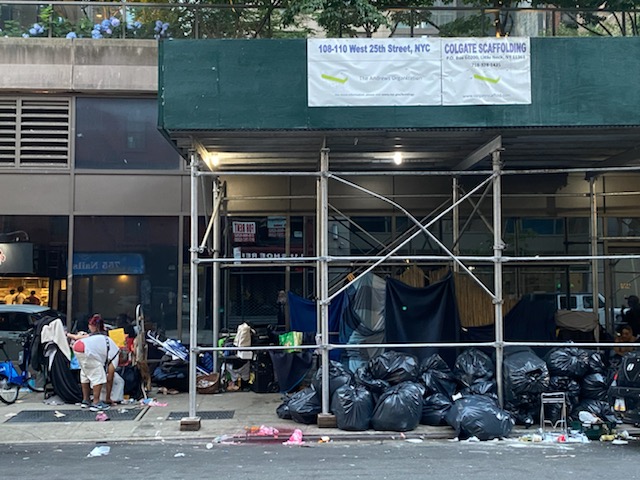
BY WINNIE McCROY | The pandemic-demanded reimagining of Manhattan as something less than a 24/7 source of retail, restaurant, and nightlife opportunities made it seem like the city that never sleeps had gone into hibernation. Tourists left in droves and have yet to return in comparable numbers; residents sheltered in place shortly after sundown; and unhoused individuals accustomed to spending their dusk to dawn in the subway’s stations and cars were forced aboveground during the system’s nightly closures. Some of that population found its way to, and underneath, the city’s plentiful sidewalk sheds (aka scaffolding), which the New York City Department of Buildings (DOB) requires when a property undergoes repairs. (a variety of factors, including work stoppage and outright neglect, can keep that shedding up for years). The unsightly grid created by its scaffolding, roofing, and mesh—meant to protect passersby from falling debris—has played host to homeless encampments and open-air drug use and sales, long before the pandemic pushed the situation to unprecedented heights.
“I’ve been on blocks where people have set up a whole living room out there, so it’s been a real challenge for the neighbors,” said Carla Nordstrom, a founding member of the West 25th Street Project, which works for the betterment of the block between Sixth and Seventh Aves. Nordstrom, who spoke to Chelsea Community News only in her capacity as a nearly three-decade resident of that block, unofficially echoed one of the Projects’s top concerns when she told us the main quality of life concern on and surrounding the block “is the use and sale of drugs.”
Near a longtime unoccupied storefront where David’s Bridal used to snake from Sixth Ave. around the corner of W. 25th St. toward Seventh Ave., drug users gather under the sidewalk scaffolding to wait for their drug dealer. Across the street, a short distance down the block, is the Bowery Residents’ Committee’s (BRC) 12-story vertical campus, which provides housing for the homeless and inpatient/outpatient treatment for substance misuse. Nearby residents say that until a very recent cleanup of the area they observed itinerants under and around the scaffolding spent their hours squatting, vending, smoking crystal meth, engaging in intravenous drug use, spreading garbage, and blocking the sidewalk.

And they appear to be savvy to the laws under which the NYPD and the New York City Department of Social Services-Department of Homeless Services (DSS-DHS) operate. The scofflaws hide under pieces of cardboard while they engage in drug use and have lookouts to warn them when officers are doing street patrols. Rather than constructing tent cities or other “structures” in front of the vacant retail locations, these malingerers hang fabric on the sidewalk sheds, so city agencies won’t have the authority to disassemble the encampment. Neighbors call it a “doom loop”—a situation that doesn’t seem to have any clear resolution.
“In our City, we don’t allow obstructions of public place or encampments and anytime the City encounters, learns of, or receives a report about a condition on the street that needs to be addressed, the City addresses it as quickly as possible, with multiple City Agencies responding as appropriate,” said a spokesperson from the DSS-DHS.
As city agencies and the NYPD worked to clean up major problem areas like W. 23rd St. and Eighth Ave. (where a mattress placed in front of the former Boston Market announced its occupant’s sense of permanence), this mini-encampment model began to spring up on side streets. The situation has attracted the attention of those in the nearby Flatiron/23rd Street Partnership Business Improvement District, which is preparing to expand their boundaries up Sixth Ave. to 31st St.
“This is right on our border, and impacts our neighbors and community, so we’ve begun to work closely with stakeholders and local precincts, City Hall and the DHS and Sanitation over the corridor at Sixth Avenue between 23rd and 25th Streets, as it is a magnet for illegal vending and other illegal activities,” said the Partnership’s Executive Director James Mettham, adding, “We are really just concerned about people being able to move safely up and down Sixth Avenue at the juncture where the F train is.”
Mettham noted that over the past few months, he has had multiple conversations with the 13th Precinct, DSS-DHS, and New York City Council Speaker and District 3 Council Rep Corey Johnson’s office about the migration of drug activity on Eighth Ave., btw. W. 20th to 23rd Sts. (where sidewalk shedding plays a role) to the W. 25th St. sidewalk shed. He said that everyone tries to act in accordance when these situations get out of hand, offering services to address it and time to clean it up before it leads to something even more dangerous. (A new initiative by the city, combined with ongoing uniform and undercover operations by the 13th Precinct, has all but eliminated the open-air market on Sixth Ave., btw. 23rd & 24th Sts., where unlicensed vendors sell their wares and, say neighbors, dealers sell drugs–activity that now takes place on nearby side streets.)
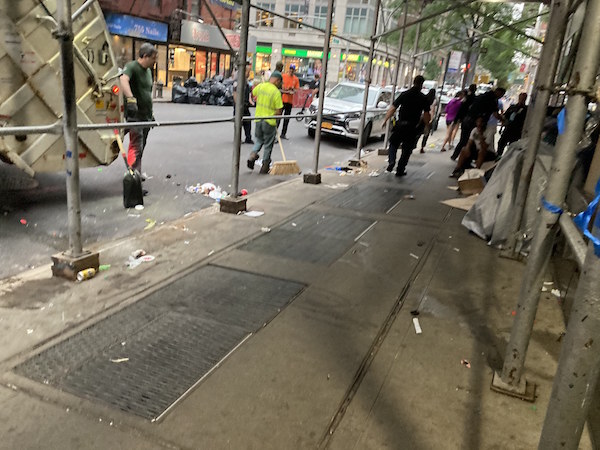
“We’re right on the fringes there, so we could be impacted by that,” said Mettham. “We’ve tried to extend our cleaning services up 23rd and 24th Streets, but we’re not to 25th yet. Hopefully, we’ll be doing that by the end of the year so our supplemental safety and cleaning services will reach this corner.” (Note: On July 29, the New York City Council approved the expansion of Flatiron/23rd Street Partnership BID’s boundaries as of Jan. 1, 2022.)
DSS-DHS is aware of the particular problems in this specific area of Manhattan and says that their Homeless Outreach & Mobile Engagement Street Action Teams (HOME-STAT) canvass this location at least six times a week and are currently engaging one homeless individual and five other potentially at-risk individuals. HOME-STAT teams have helped get thousands of New Yorkers off the streets and subways. And they say that as of the week before last, the problematic area on W. 25th St. had been cleared.
“Whenever DSNY or another partner Agency addresses a condition on the streets, we at DSS-DHS and our outreach partners are on hand, continuing to engage any individuals on-site, building on trust and relationships with those individuals, and outlining the range of services available to them,” said a spokesperson for DSS-DHS. “We know that it can take hundreds of interactions to encourage an individual to accept services and transition off the streets—and our dedicated outreach teams are prepared to keep coming back to make that breakthrough.”
Spillover From the Homeless Shelter? | With the BRC shelter on the same block (131 W. 25th St. btw. Sixth & Seventh Aves.), some community members cast the blame on their residents, many of whom are returning to live at the BRC now that the pandemic hotel room accommodations are ending for many unhoused individuals.
DSS-DHS says that they have been working since January 2020 to increase options and provide a pathway off the streets for New Yorkers in need, with a spokesperson telling Chelsea Community News, “We’ve opened more than 1,300 specialized beds dedicated to serving and supporting unsheltered individuals, including new Safe Haven beds and stabilization beds we established in commercial hotel locations—and these vital beds are already proving to be an invaluable resource for outreach teams, helping hundreds of individuals who were residing on the streets get back on their feet.”
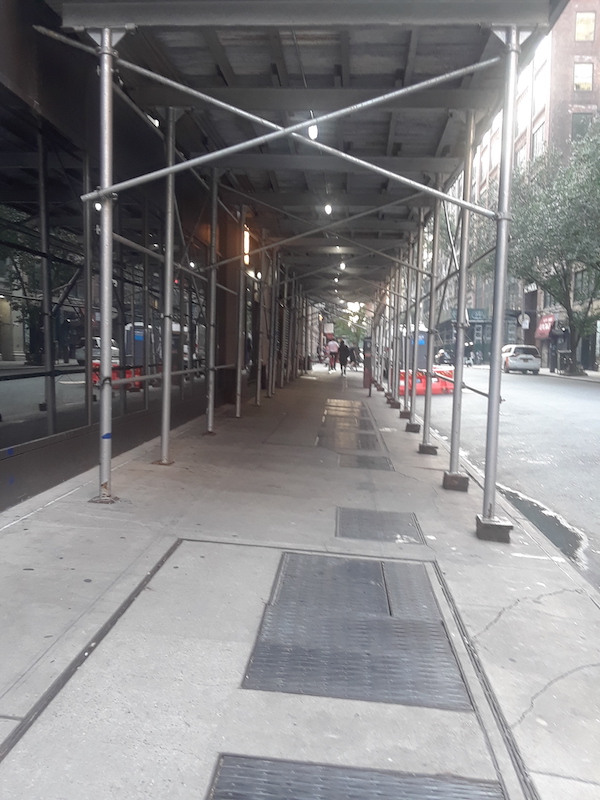
To wit, neighbors who live amongst the midst of the chaos say they don’t believe the drug encampment is largely populated by BRC residents—or any shelter residents at all. One neighbor said that the folks who show up every day to do drugs in front of their house are itinerants who do not live at the homeless shelter, and who decline efforts by the local street outreach group, Breaking Ground, to provide housing.
“It’s my understanding that this is not BRC residents,” echoed Mettham. “They’re dealing with the return of their residents and clients, but they are continuing to work with the community. Our BID provides homeless outreach via Urban Pathways, and we will be expanding that. Most of the current engagement is done by DHS and outreach teams from Breaking Ground, who are deployed particularly in places where makeshift tent cities go up. So they are responding, but finding that other activities are happening here—that folks are using this sidewalk shed for something other than shelter.”
But even those community members who don’t believe the encampment is comprised of BRC clients want BRC to respond. Longtime block resident Nordstrom said that when BRC first moved in, complaints about drug use were met with increased foot patrols by DHS Peace Officers. Nordstrom would like to see that continue, recalling a time when she said Speaker Johnson allocated funds for these DHS patrols.
Chelsea Community News wrote Speaker Johnson’s office with a request for on-record comment as to about what plans his office they had made to tackle the problem on W. 25th St.—but the spokesperson’s response stopped short of providing any tangible insight or information, simply noting, “The district is working with DHS and numerous city agencies to address this situation.”
Nordstrom said that because the BRC shelter was larger than other 200-person shelters (it houses up to 328 residents), she felt they should do their part to resolve this “unwieldy situation.” In the past, the community pushed BRC to make things better, but with the confusion around COVID housing, Nordstrom feared community safety was backsliding, and was “worried we’re going to end up back in the situation we had before.

A New Initiative is Helping | In response to this heightened sidewalk drug activity in Chelsea and Midtown is the NYPD’s Business District Recovery Initiative Detail. Led by Deputy Inspector Steven Hellman, the Detail patrols city streets, working with external partners at the DHS, NYC Health + Hospitals, the NYC Consumer Affairs Department, and the Department of Sanitation (DSNY) to keep the sidewalks safe and clean.
Appearing by invitation before the full board of Manhattan Community Board 4 (CB4) on June 2, Hellman described the newly formed unit in detail, noting it took part in “47 successful cleanups” since its April, 2021 debut (that stat is now in the hundreds, noted Hellman, just prior to this article’s publication). To access the archived Zoom footage of Hellman’s Q&A with CB4, click here (minutes 1:15 to 17:25).
“We currently have one inspector, seven sergeants, one lieutenant, and 90 police officers” comprising the Detail, noted Hellman, to Chelsea Community News. “We are working on quality of life issues in the Midtown area as well as throughout the city. We’re engaged in joint operations working with homeless encampments, mental health removal orders, and open-air drug markets.” Low-level narcotics abuse, aggressive panhandling, random assaults, and acts of menacing are also of concern to the detail, noted Hellman, who told CB4 its effectiveness stems from “my cops being out there, begins seen on foot, and connecting with the businesses,” adding that as of now, its areas of coverage are on Canal Street, from W. Broadway to Centre (the counterfit vending beat), and, in the Midtown zone, from Fifth to 10th Aves., 34th to 59th Sts. “It’s a pilot program now,” noted Hellman, but it “could become a citywide, permanent project.”
Regarding the dimension of its current Midtown footprint, Hellman is familiar with the area, as he used to serve as Commanding Officer of the 13th Precinct, which covers some of Chelsea’s easternmost portion (including the open air market on Sixth Ave., btw. 23rd and 24th Sts.). Hellman said he has good relations with Speaker Johnson’s office, and is aware of the areas where there are encampments, and the complaints around drug use. He told Chelsea Community News that he speaks daily with his successor at the 13th Precinct.
“[Commanding Officer] Deputy Inspector Figueroa has a steady sector, and we’re helping as well,” said Hellman. “I think it’s a very positive thing. It’s about outreach, help, and good old-fashioned policing to improve quality-of-life issues.”
“It’s important that when people come across dangerous activities that they get in touch with the police,” said Mettham. “I know we’re all sensitive to doing that and need to make that judgment call but reach out to 911 or 311 when someone’s in danger, either someone in that location or someone who is passing through it.”

Mettham said that “Inspector Hellman has been terrific in this initiative, and is very responsive with his crew and is familiar with the area as he was the previous 13th Precinct CO. Everyone’s hands are tied to a degree, and everyone’s gotta play their role: The police, the DSNY, property owners, the community. This will take an ongoing and concerted effort.”
For his part, Flatiron/23rd Street Partnership BID’s Mettham urged community members to not be reticent, saying, “As issues arise, reach out to us. We have a good relationship with various city agencies, and we can get in touch with them to elevate it. It’s not just the responsibility of the police, whether or not it’s a homeless issue, a sanitation issue, or a medical issue.”
Nordstrom believed a Detail like this could help but bemoaned the fact that such a presence wasn’t always on the block, saying “the DHS Peace Officers were in uniform, so people took them more seriously. They didn’t go at and catch criminals, but some of them were really good at talking to these people.
The DSS-DHS spokesperson told Chelsea Community News that their new interventions and outreach teams had “helped more than 4,200 individuals come off the streets and remain off under the HOME-STAT program, which is the most comprehensive outreach program in the nation. Our outreach teams canvass this neighborhood several times a week and have made five recent placements from this area to transitional or permanent housing opportunities.”
In her effort to have safety issues on her block addressed, Nordstrom said she attended the BRC’s Community Advisory Council meeting on Tuesday, July 13. She said BRC told neighbors it wasn’t their clients, and that the DSS-DHS said all they can do is encourage people to seek services, saying additional foot patrols had been defunded.
Frustrated with what she saw as a lack of responsiveness, Nordstrom drafted an email to neighbors on behalf of the West 25th Street Project, urging them to contact Speaker Johnson and their other elected officials to help reinstate DHS Peace Officers on W. 25th St.
“The BRC headquarters is one of the largest service providers for unhoused people in the city, and so having an encampment with drug use on their block is a terrible look,” Nordstrom told Chelsea Community News. “You have to wonder what they are doing. Their attitude is always, ‘It’s not our people,’ but that’s not the way it should be. If you have a big shelter on your block, you should go out of the way to make sure it’s the most safe, beautiful, cleanest block in the city, for the residents of the shelter, the workers, and the neighbors. So, this is very discouraging. If people who are supposed to know how to deal with these kinds of problems are not able to, where does that leave everyone else?”
Hellman said that neighbors concerned about drug activity or experiencing it on their block should feel comfortable calling 311 or participating in the monthly Community Council Meeting and the quarterly Build the Block meetings (with the Neighborhood Coordination Officers, or NCOs). If the situation is dire, such as witnessing an overdose from injection drug use, Hellman urged folks to contact 911.
“Call 911 if you see someone using drugs,” advised Hellman. “Be vocal.”
–additional reporting by Scott Stiffler
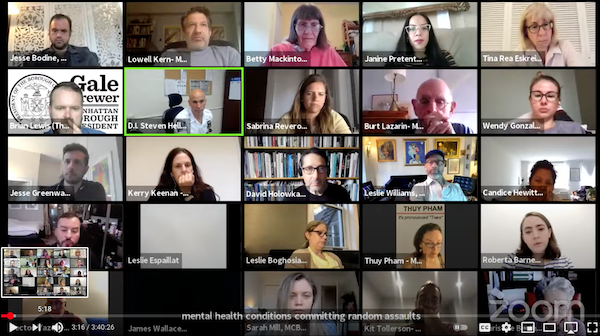
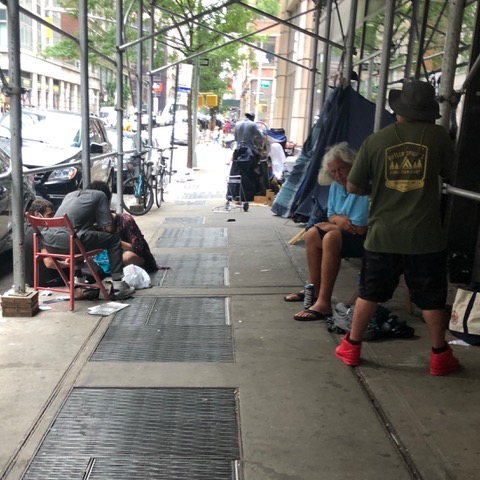
Chelsea Community News is made possible with the help of our awesome advertisers, and the support of our readers. If you like what you see, please consider taking part in our GoFundMe campaign (click here). To make a direct donation, give feedback, or send a Letter to the Editor, email scott@chelseacommunitynews.com.

Pingback: School Mostly Mum on 60K MacBook Burglary; NYPD Parcels Bits, not Bytes, to Media – Chelsea Community News
Pingback: Recidivist Chelsea Burglar, ID’d as April Stabbing Assailant, Behind Bars as Mental Health Questions Linger – Chelsea Community News